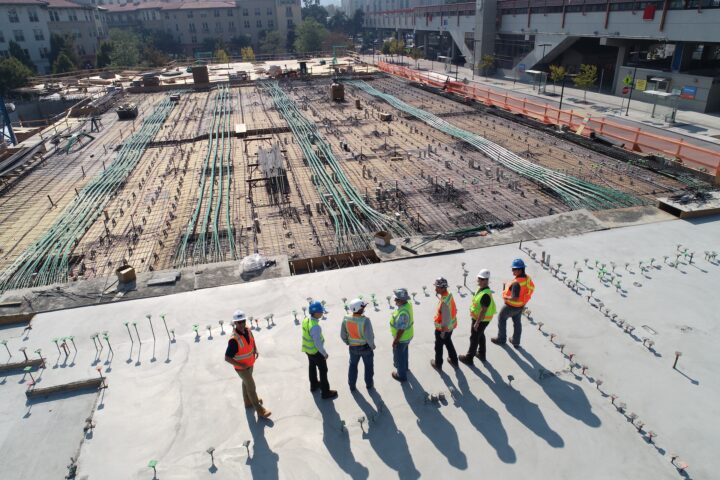The Top 7 Trends Shaping the Future of Construction Estimating
Stepping into a new era, the construction industry confronts a landscape deeply shaped by technology, sustainability, and digital innovation. Navigating this terrain demands creativity, foresight, and precision in the vital construction estimating process. With its roots firmly planted in tradition, this critical practice is being reimagined for a new age, promising exciting developments.

1. Digital Transformation
Digital technologies are the engines powering a new age of construction. Tools that were once a mere convenience have become integral to everyday operations, driving accuracy, efficiency, and communication in every facet of the industry. The impact of this trend is most clearly seen in the realm of construction quotes. No longer confined to paper and pen, construction quotes have entered the digital sphere, revolutionizing the speed, precision, and ease of cost estimation.
The digital transformation of construction estimating isn’t merely a trend—it’s a paradigm shift. The marriage of technology and estimation has given birth to a new age of accuracy, responsiveness, and comprehensibility. Gone are the days of manual calculations and best guesses. Today, the industry enjoys an environment of precision, fostered by robust software platforms like CostCertified. As digitalization pushes the boundaries, construction estimating will evolve, making it more reliable, accessible, and efficient.
2. Rise of Sustainable Construction
The construction industry is on the frontline as global consciousness shifts towards a more sustainable future. This trend extends beyond the use of green materials and energy-efficient designs. It permeates every aspect of the industry, including construction estimating. Today, estimates must consider the cost of sustainable materials and practices, reflecting the industry’s commitment to minimizing its environmental footprint.
In the coming years, this trend will only deepen. Creating a sustainable construction estimate will become increasingly complex with the rising demand for green construction. Contractors and engineers must balance cost-effectiveness with eco-friendliness, making educated decisions based on current market trends, material availability, and best practices in sustainable design.
3. Adoption of BIM
Building Information Modelling (BIM) has rapidly evolved from a promising technology to a critical tool in modern construction processes. It provides a visual, detailed, and dynamic 3D model of a project, allowing stakeholders to visualize the finished product even before groundbreaking. This powerful tool greatly benefits construction estimating by providing in-depth information, mitigating oversights, and reducing quote inaccuracies.
As BIM software becomes increasingly sophisticated, it promises to revolutionize the estimation process further. With detailed and accurate models, contractors and architects can produce precise estimates, minimize costly errors, and streamline project management. This shift towards BIM signifies a movement towards precision and fosters transparency between contractors, clients, and stakeholders, building trust and setting the stage for successful projects.
4. The Internet of Things (IoT)
The Internet of Things (IoT) has proven to be a game-changer in many industries, and construction is no exception. IoT devices help improve job site safety, coordination, and efficiency. These devices also enhance construction estimating by providing real-time data on material usage, labor productivity, and equipment status.
In the future, IoT will play an even more significant role in shaping the way construction estimates are conducted. As data becomes more accessible and reliable, contractors can make better-informed decisions, create more accurate estimates, and ultimately deliver successful projects.
5. Machine Learning and AI
Integrating machine learning and AI into the construction industry has been slow. However, as the potential of these technologies becomes clearer, their adoption is gaining momentum. They have the power to analyze large amounts of data, learn from it, and provide predictions or recommendations based on detected patterns. In a construction estimate, this can translate to anticipating potential costs, identifying trends, and providing more accurate quotes.
6. Cloud-Based Estimation Software
The rise of cloud technology has revolutionized many industries, with construction being one of them. Its impact on construction estimating has been particularly profound, providing unparalleled flexibility and accessibility. A perfect example of this shift is the growing adoption of cloud-based remodeling estimate software, which allows contractors and estimators to access and manage their estimates from anywhere.
This trend will likely continue, with cloud-based estimation software becoming the norm rather than the exception. Its ability to provide real-time updates and easy accessibility make it an invaluable tool for contractors. As the industry continues to embrace cloud technology, construction estimating will become even more dynamic, precise, and efficient.
7. Mobile Estimating
In a world where speed and accessibility are paramount, mobile estimating is rapidly gaining traction. It enables contractors to generate a construction estimate quickly and efficiently from their mobile devices. This ease of access allows for immediate updates, faster turnarounds, and improved customer service, which is invaluable in today’s fast-paced construction industry.
Mobile estimating will become an even more integral part of the construction industry. As technology continues to evolve, so too will the capabilities of mobile estimation, paving the way for a future of seamless, on-the-go estimating. This development signifies the industry’s adaptation to a mobile-first world and its commitment to delivering efficient and timely services.
As we steer into the future, the construction industry stands on the cusp of unprecedented innovation and change. All these emerging trends are reshaping how estimates are generated and used and setting the stage for a more efficient, transparent, and sustainable industry.
By embracing these developments, construction professionals can deliver more accurate and reliable projects, driving growth and prosperity in the sector. Undoubtedly, these exciting advancements signal a vibrant and promising future for construction estimating.


